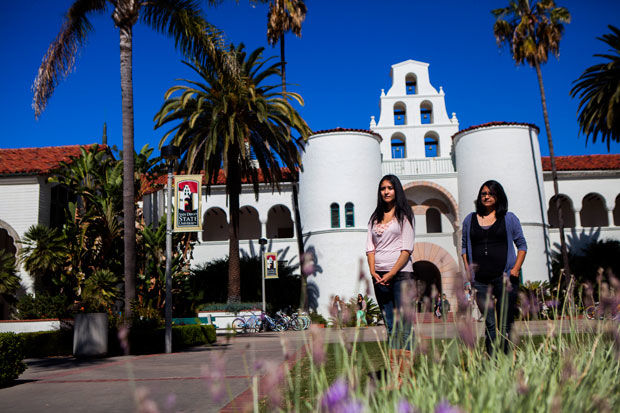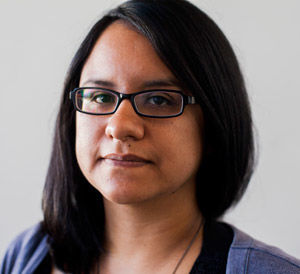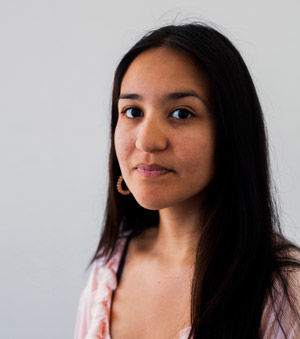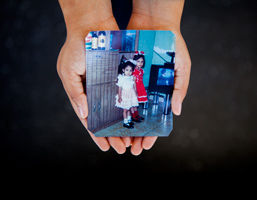
Diana and Carolina Valdivia as children
Diana Valdivia (in red, three years old) and her sister Carolina (in pink, age two) crossed illegally into the U.S. as children. Now with advanced college degrees and ready to make their own ways in life, they are frozen in an immigration no-man’s-land.
A young generation of undocumented persons, who once crossed the U.S.–Mexico border because their parents did, are speaking out about their illegal status creating perpetual obstacles—in one case, the ability to earn a Ph.D.
The official letter printed on the nice paper should’ve only meant good news for Carolina Valdivia.
After months of waiting, the door to her doctoral degree in sociology had swung wide open. One of the country’s most prestigious schools, The University of Chicago, said yes to Carolina. The offer was incredible. A full ride: tuition and a stipend.
And yet those familiar, nagging questions resurfaced. How could Carolina save enough before leaving to afford flights back home to Escondido? How could she help support her family if she was studying full-time, half a continent away?
And what about the all-caps warning on her Social Security card, the implied expiration date?
VALID FOR WORK ONLY WITH DHS AUTHORIZATION.
Twelve years after crossing the border, the invisible walls of life in the United States couldn’t have been more real.
Carolina Valdivia is an undocumented immigrant. So is her older sister, Diana. Carolina is 24 and chic, all dresses and lavender toenails and big sunglasses. Diana is 25 and leans hipster: dark-rimmed glasses, fedora, jeans.
They don’t have green cards, but they do have curriculum vitae. Both earned bachelor’s degrees from California State University San Marcos and master’s degrees from San Diego State University. Both want to earn Ph.D.s and become professors.
They want to plan their futures, but they have two-year deportation deferrals that expire next year and no defined route to citizenship. They expect to be able to renew the deportation deferrals, but that process is as yet undefined.
Carolina and Diana are Dreamers, named after the failed federal DREAM Act (Development, Relief, and Education for Alien Minors), which would’ve created a path to citizenship for them and the capproximately 2 million young people living in the United States today whose families came to this country without legal authorization. They are children who weren’t given a choice. Their parents crossed, so they did, too.
They’re in the vocal generation of undocumented immigrants that’s emerged from the shadows, using their own success stories as an advocacy tool. The movement is led by prominent figures like Pulitzer Prize winner Jose Antonio Vargas, who’ve helped redefine the undocumented label. They’re part of the first generation of undocumented immigrants using social media to create political pressure, says Tom K. Wong, an assistant professor at UC San Diego who specializes in immigration policy and knows Carolina and Diana.

Diana and Carolina Valdivia as children
Carolina and Diana Valdivia at San Diego State University. Bachelor’s and master’s degrees accomplished, they both want to earn Ph.D.s, but are frustrated by the uncertainty that clouds their future.
“Social media has made coming out more of an accepted, and, in some cases, expected type of action and social protest among undocumented youth,” Wong says. “Coming out doesn’t have the same negative consequences as it has in the past. [Social media] isn’t something undocumented immigrants had in the past. They weren’t connected in a way that they found allies easily and in a way that their individual plights and circumstances could raise to the level of national attention.”
In the immigration reform debate, both parties generally support citizenship for people like Carolina and Diana. But Congress hasn’t yet created a path for them.
Carolina and Diana came here carrying toys and clothes and nothing more. It was October 2001. Tourist visas that had been a ticket for back-to-school shopping trips between their home in Mexicali and El Centro suddenly became something more.
Carolina was 12. Diana was 13. Enough time has passed that the memory is a fragmented collage. Say goodbye to your friends, their parents told them.
These are the things that now, so many years later, they still remember: Doubting their parents’ promise. Not wanting to leave. Crying. Driving Interstate 8, successfully passing a Border Patrol checkpoint. Arriving in a bare Escondido apartment and sleeping for weeks on a floor with blankets but no beds. Coming to a foreign place that didn’t seem so foreign.
They crossed after September 11, 2001, after the terrorist attacks that refueled the country’s vitriolic border security debate. But when they arrived, Carolina and Diana didn’t feel like undocumented immigrants.
They were just middle schoolers who spoke as much English as they’d learned singing along with Avril Lavigne and the Backstreet Boys, living in another Southern California city filled with kids just like them.
They would grow into the label, but not yet.
As children, the United States had never been far away. They’d lived in border cities, Mexicali and Ciudad Juarez, affluent enough to be able to afford shopping trips north of the border. They’d traveled to see an uncle in Los Angeles.
Visiting was a privilege. But this country wasn’t an idea, an object of envy, a gold-paved cliché. It was where Wal-Mart and Target were. Where Michael Jordan played for the Bulls, their father’s favorite NBA team. Where they could feast on Mrs. Fields cookies, where Carolina could eat at her favorite spot, a fast-food restaurant she adored so much she wanted to be renamed Carolina Wendy Valdivia.
“The two countries almost blended at the border for me,” Carolina says. “A lot of things were different, but there were similarities I hung on to. It was normalized: It’s fine if you just show your visa, go through, and come back that day. I didn’t think anything about being in a foreign state.”
Carolina and Diana didn’t feel different, even when they started school in Escondido. They took classes together, surrounded by other English learners. They only had to survive phys ed classes with everyone else.
They didn’t feel strange.
They didn’t yet know why they should.

Diana Valdivia
Diana Valdivia (top) and Carolina Valdivia (bottom)

Carolina Valdivia
Diana Valdivia (top) and Carolina Valdivia (bottom)
Today, they recall dozens of scenes from being undocumented, from realizing they were undocumented.
Diana turns 16, then Carolina follows. Their friends get drivers’ licenses. They don’t.
Carolina is in high school, heading to a quinceañera in Temecula with the family of a boy she’s just started dating. She knows they’ll pass a Border Patrol checkpoint en route, so she confesses her status in the car. Her boyfriend hadn’t known. His father is incensed. A week later, they break up. (Because the boyfriend’s mother didn’t want him dating, not because of her status, she says.)
Diana, the first in her family to go to college, watches as her friends apply to Berkeley, Santa Barbara, Irvine. She gets accepted at Cal State Fullerton. She’s excited. Then reality sets in. She doesn’t have a license to drive there and back home, or even a car. She chooses Cal State San Marcos, close to Escondido, instead.
A year later, Carolina is accepted at UC Santa Cruz, travels there on an organized bus trip, tours the campus, and is convinced she’d love to attend. But she doesn’t have a car, either. Or an ID to travel by air. Or the ability to get a job legally. She can’t get a school loan unless a U.S. citizen co-signs it. She chooses Cal State San Marcos, too.
Carolina finds a retail job to pay for school. She works there a month before they summon her to the office and say her name and Social Security number don’t match. If you ever have the ability to come work, we’d love to have you, they tell her. She goes home in tears.
Fast-forward to Carolina’s second year of undergrad. She is one of four people chosen to travel to Washington, D.C., to give a presentation on the DREAM Act, the failed federal legislation.
But paperwork needs to be completed, and it asks for her Social Security number and identification, which she doesn’t have. So she can’t go.
The fear, the frustration of not having papers surfaces again and again.
Carolina, driving to work one day during her junior year, gets a few blocks from her house when another car runs a stoplight and slams into her. She blacks out. As she’s regaining consciousness, neighbors come running. Smoke is pouring out of the car. Guys help pry open the door, shouting for her to get out.
And all Carolina can think is that she needs a phone to call home, to find out what to do. The cops are coming, and she isn’t here legally, living in a city that coordinates checkpoints with federal authorities to find people like her. She remembers thinking, amid her panic: Are they going to take me?
The police arrive and ask if she has a license. No, she says. They ask if she needs to go to the hospital. No, she says. She doesn’t have health insurance and imagines how expensive an ER trip would be. She isn’t arrested, though, winding up instead with a misdemeanor and a fine.
These scenes punctuate their time in college and grad school. Dodging police checkpoints. Worrying when a cop was nearby. So much so that Carolina and Diana both began feeling trapped. The U.S.–Mexico border, the line that once blurred two countries, became a dividing line—between life here, and the life and family they left behind. They were fearful to even go near it.
“It’s totally different now,” Carolina says. “We know where the border is, exactly how far it goes, exactly what it means physically and emotionally. The border doesn’t blend in. It’s very present. It symbolizes what we can’t have.”
“Mexico is right there,” Diana says. “But it’s not.”
With Border Patrol checkpoints on every major interstate, they carved out a niche between San Diego and Escondido, knowing where they could and couldn’t go, borders within the border. The older they got, the more they began identifying with lyrics written by Los Tigres Del Norte, a popular Mexican-American band, particularly the song “La Jaula de Oro”—the Golden Cage.
What’s money good for, if I live like a prisoner in this great nation.
When I’m reminded of this, I cry. Although this cage is made of gold, it’s still a prison.
That’s slowly changing, as laws improve for undocumented immigrants like Carolina and Diana. By their second year of grad school, California had made it legal for them to receive state financial aid. And though the federal government hasn’t created a path to citizenship, it did create the temporary deportation deferral program that allows them to work legally.
And though they didn’t get them at 16, Carolina (then 23) and Diana (then 24) finally received drivers’ licenses last December.
The question comes too frequently. Where are you from? The answer, for two residents who aren’t citizens, is never easy. When a friend asked Carolina recently, “I just stood quiet,” she says. “I don’t know what they want me to answer. I’d have to tell you my whole life story.”
Neither sister feels American. The country’s policies haven’t embraced them. This isn’t capital-H Home, it’s a home. But they don’t identify as being Mexican, either. Mexico is a home, but it’s one they haven’t seen in more than a decade. Home is California, Mexicali, Escondido, the United States, Mexico—and none of those places.
They settled two hours from the city where they grew up, where their extended family still lives. But they’ve never returned. They couldn’t. Not if they wanted to come back in.
Cousins have been born, grown up, and Carolina and Diana have never met them. They’re Facebook friends instead. One cousin messaged Diana recently on Facebook. She didn’t know how to respond.
“In a way, I want to talk to her,” Diana says. “But in a way I can’t because I don’t know what to talk about. It would be a lot easier if I could have coffee with them. When you’re chatting online with them it’s different. It’s so different.”
Diana has been more private about her status than Carolina. In college, Diana found a job at an insurance company that she knew would pay for her schooling. No one there asked about her work eligibility and she didn’t volunteer her status. “I wasn’t going to do anything to harm that job,” she says.
Their status limited their options. They didn’t have work permits for the paid assistantships and research jobs other students took. While colleagues in her master’s cohort got more experience by working on campus, Carolina babysat.
But as they’ve grown into their undocumented status, they’ve learned that the obstacles are part of their unique American experience. Carolina and Diana aren’t ashamed to be undocumented. They’re fascinated by it. As they climb farther into academia, their status influences what they want to study: migration trends, how being undocumented affects families, couples, relationships.
Carolina has embraced the increasingly emboldened stance of a generation of Dreamers like her, pointing to their advanced degrees to convince the country of their value. She’s blogged about it. She and Diana started a Facebook page called UndocuPick-upLines with two friends. (Sample: “You’re so hot you could melt I.C.E.”)
For now, Diana is working as an organizer helping get undocumented youth like her enrolled in a temporary deportation deferral program. She wants to start applying for Ph.D. programs next year. Carolina is working with Wong at UC San Diego, researching immigration.
She’s deferred her acceptance to University of Chicago for a year, hoping to save money first. She plans to start next fall. Still, she feels frustrated by the uncertainty that clouds her future.
“I’m trying to make plans,” she says. “I want to pursue my Ph.D. I want to teach. I want to do all these things. But I can’t guarantee anyone—the university, my family, my friends—that I’ll be here in the next five years or the next 10 years.”
In the meantime, she and Diana both hope Congress will pass a comprehensive immigration reform measure. Then the weight they feel might be lifted, and the nagging questions might be answered.
Tijuana’s hills grew in the distance. The border drew closer. LAST USA EXIT, the signs warned. As they got closer to the San Ysidro crossing, Carolina’s boyfriend turned down the music, afraid of what would happen if he missed his turn.
It was a Sunday in late July. They’d come for a protest. For the first time since crossing north in 2001, Carolina and Diana were returning to the border, close enough to see the country they’d left.
There it was. A Mexican flag flew high. The rusty border fence snaked up the hills. People streamed in. Diana and Carolina watched them walk through, feeling a twinge of jealousy. “For one second,” Carolina says, “it would’ve been nice to imagine that I could cross that border and come back.”
Diana hadn’t known what to expect. She’s seen the border in her dreams. It didn’t look like that, the smoggy chaos of two countries smashing together at San Ysidro.
In her dreams, she’s been in Mexico, sometimes at her childhood home. In one, she’s trying to cross into the United States. The port of entry is calm, just a few people milling. But something’s wrong: she can’t get back in.
In another, she’s with her mom in Mexico. An aunt has passed away. It’s a manifestation of a fear she lives with, that family there will die and she won’t be able to attend their funerals. She’ll wake with a shock.
But often, she’s just back south of the border, spending time with her family, living a life that doesn’t exist any more.
PARTNER CONTENT
“Those are definitely not nightmares,” she says. “They’re nice dreams.”

















